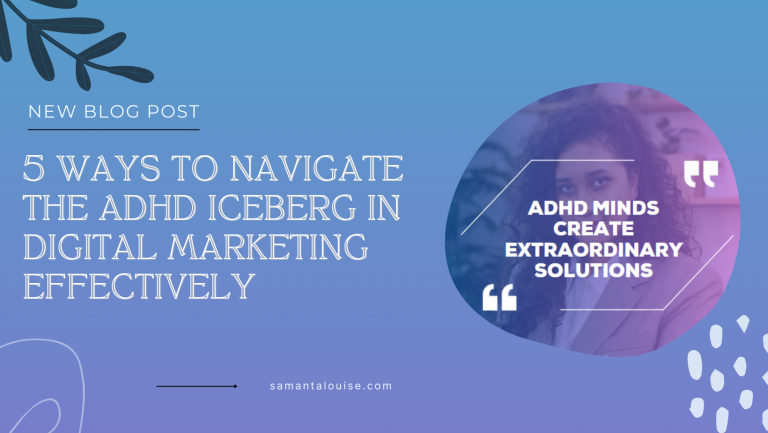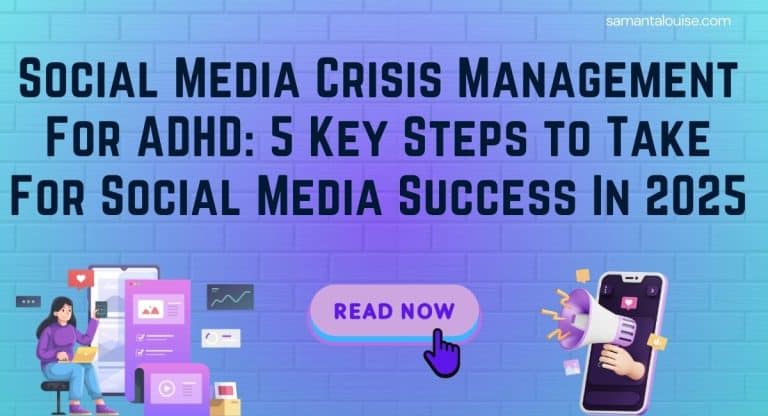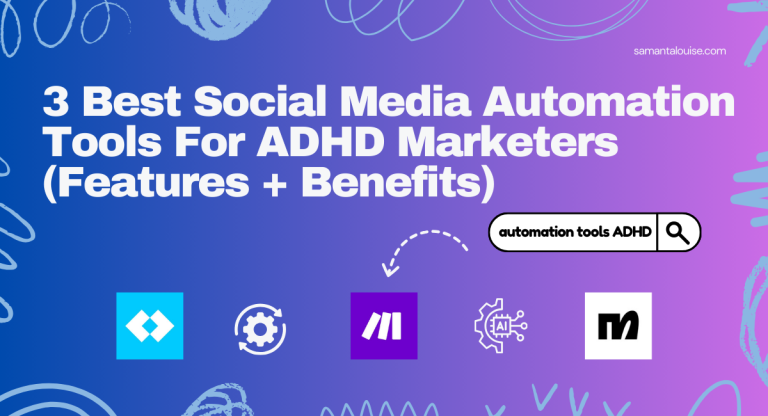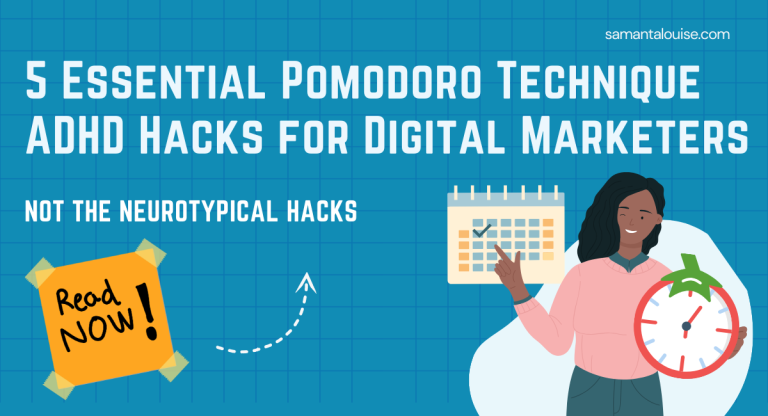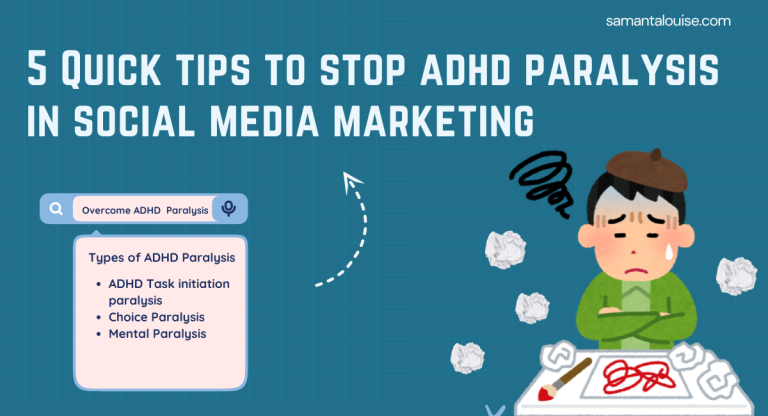19 Best Social Media Tools for ADHD Entrepreneurs in 2024 (Pricing + Features)
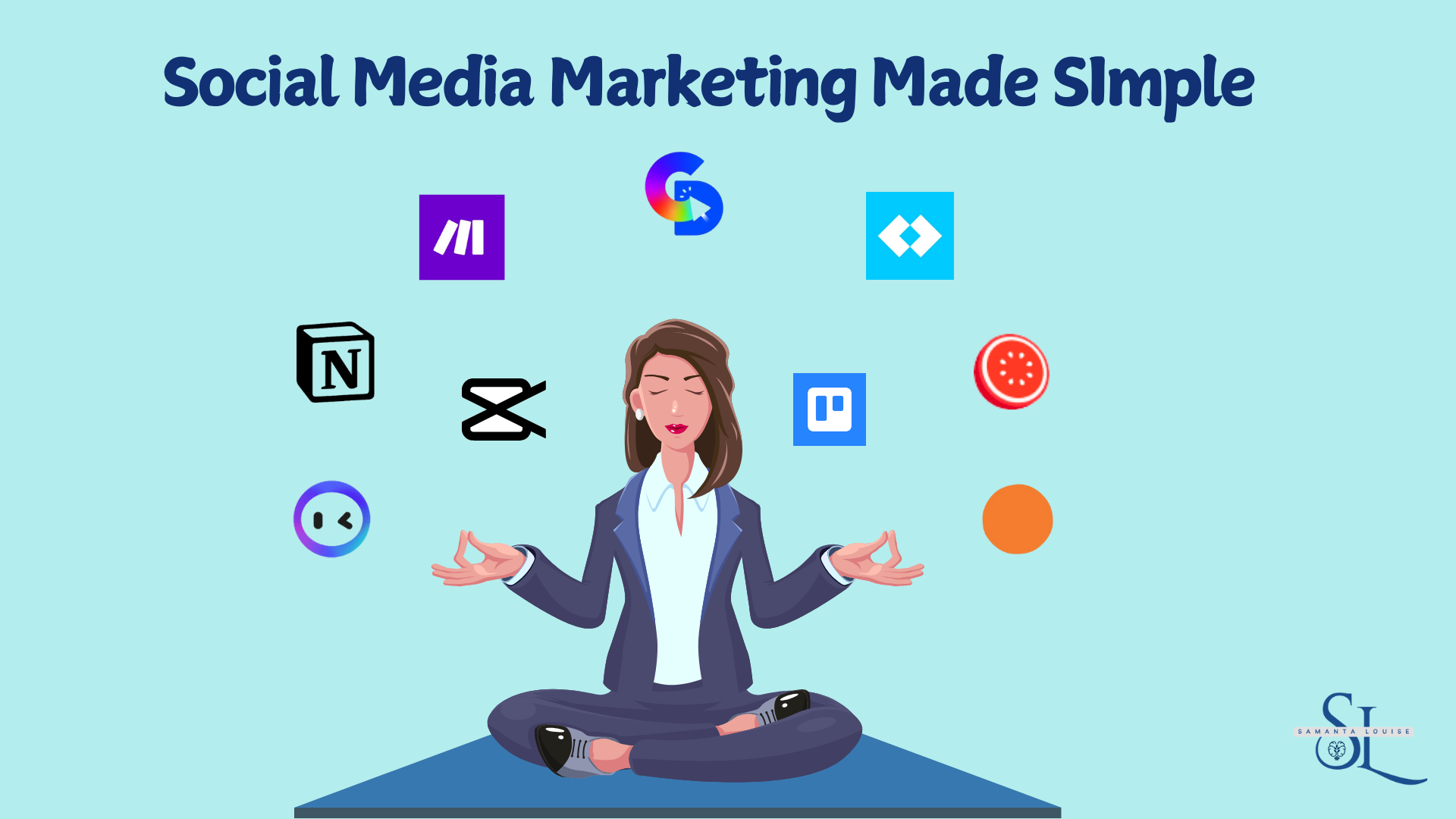
Have you ever felt like your ADHD brain is your biggest challenge in social media marketing? You are not alone.
That’s how I felt until I started to use the best social media tools for ADHD entrepreneurs I found upon testing multiple apps and tools.
As a digital marketer with ADHD, I have had my fair share of sleepless nights trying to come up with a first draft while having a million ideas buzzing in my head… I have also battled with inconsistency, imposter syndrome, inability to focus, low morale, and indecisiveness in my journey.
From creating the best viral content to managing your social media presence, these powerful ADHD-friendly tools and apps stand out.
These game-changing social media tools for ADHD entrepreneurs have transformed my ADHD-fueled chaos into a consistent content powerhouse, boosting quality and preserving my sanity.
In this guide, I will walk you through the best social media tools for ADHD entrepreneurs that bring insane value to my work and transform my marketing chaos into strategic brilliance. I will cover their main features, pros, cons, and free alternatives, as well as their freemium version, which can help you transform your ADHD-fueled chaos into marketing brilliance.
Why ADHD Entrepreneurs Need Specialized Social Media Tools?
When I first started my online business, I was so excited about the possibilities of social media marketing to grow my loyal customer base and reach out to more potential customers. But soon after, I was hit by a huge hammer of ADHD challenges that made social media marketing harder.
It was a not-so-fun rollercoaster of inconsistency, time management struggles, constant distractions and overwhelming platform diversity.
The truth is that the ADHD brain does not function like the neurotypical brain. You could try to convince yourself otherwise, but it would only lead to more self-loathing, demotivation and inconsistency.
A crucial step in managing ADHD more effectively is changing your perspective and taking the right actions to overcome the challenges and turn your symptoms into advantages.
And the easiest way to do that is to use ADHD-friendly tools and apps that help you in your social media marketing journey.
What are the best social media tools for ADHD entrepreneurs?
After testing and using these ADHD-friendly apps and tools, I’ve curated a list of 11 must-have social media apps and tools that have become indispensable in my marketing toolkit. The best part? Most of these ADHD tools for adults are available in freemium versions.
Overview of my favourite social media Tools for ADHD Entrepreneurs (What I Use)
- Clickdesigns: Best for Visual Content Creation
- Notion: Best for Note-taking and Planning
- Trello: Best for Task Management
- Focus to do: Best for Focus
- Habitica: Best for Routine Building
- Make: Best for Automating Tasks
- Thriendly: Best For Threads
- Grammarly: Best for Grammar Check
- Balance: Best for Meditation
- Monica AI: Best for AI writing and Editing Assistance
- Later: Best for Content Planning and Scheduling
Out of the 21 best social media tools for ADHD entrepreneurs, I personally use these 11 apps and tools. However, the remaining 10 apps and tools are similar and may vary in terms of pricing.
Now that you’ve seen the overview, let’s jump into each of these best apps in detail. I have segmented this guide into the following sections to navigate the tools and apps.
Visual Content Creation and Scheduling Tools for Consistent Posting
1. ClickDesigns

Clickdesigns is one of the best social media tools for ADHD entrepreneurs because of its AI-integrated features and simplicity. You can use it to create eye-catching content through drag and drop, which makes content creation easier and faster.
It is similar to Canva but maintains a simpler interface with all the features that you need for content creation. The AI tools such as the A.I copywriter, image creator, social writer and image editor can help to create content quickly and without limitations.
I get to create unlimited designs and projects which makes my social media marketing experience easier. I use the cover and mockup creator to visualize products and content quickly, which helps to maintain interest and momentum in projects. I do not have to be a graphic designer or have experience in graphic designing, everything is drag and drop and pre-created.
I got Clickdesigns Lifetime for $47 only by purchasing it from OLSP. So if you are looking for a cheap option for designing your posts, logos, mockups, videos and editing, ClickDesigns is for you.
Pros
- It is quick and easy to use with its drag-and-drop interface for unlimited designs and projects.
- You will have professional-looking results despite having no graphic design experience.
- The AI will allow you to save time in your design process
- There is a knowledge base where users can find more information about how to use Clickdesigns
Cons:
- There may be limited advanced design features for complex projects such as video transitions
- You will have to pay a monthly subscription or you can get it for $47 Lifetime using this link
ADHD-Friendly Benefits
- Clickdesigns reduces overwhelm with a simple, guided design process and does not have extra unnecessary features to confuse users.
- It provides structure through templates, pre-made graphics and stock photos, helping maintain focus in the design process.
- You can get quick results which is good for shorter attention spans
2. Canva
Canva is the design mogul for people who want to design something despite having no design experience. You can have a free account and get access to a wide range of customizable templates for various marketing materials including logos, posters, flyers, brochures, social media posts, websites, stickers and much more. Of all the best social media tools for ADHD entrepreneurs, this is a must-have if you have no design tools.

Before I moved to Clickdesigns, I used Canva for 5 years. It is an essential branding tool with its branding kit feature allowing you to store important information such as logo, and color palette in one section. The drag-and-drop interface is intuitive.
I have used Canva to create my Facebook, Instagram and TikTok posts. With the unlimited stock photos and videos, I created many faceless aesthetic videos which helped me grow my social media accounts.
Canva pricing is a simple monthly subscription of $12.99 per user or $119.99 per year. You can also pay as you go for individual premium designs or graphics. Canva can be an invaluable tool to create professional-looking materials efficiently.
Pros:
- Canva is very user-friendly for beginners with no design experience
- It is a versatile design platform for various design needs such as posters, videos, photos, infographics and logos.
- Canva does regular updates with new features such as AI tools, new stock photos and videos, templates and much more.
Cons:
- The free version has limitations on the available stock media, graphics, and AI features.
- It can be overwhelming with too many options available, especially for users with ADHD.
ADHD Benefits:
- Its visual interface aids in maintaining attention and avoids design overwhelm in the design process.
- The templates provide starting points, reducing decision fatigue when designing your next piece.
- The ability to save brand kits helps with consistency in your designs.
3. Capcut

If you are a video content creator, Capcut might be the perfect editing tool for you. It provides a user-friendly platform that is available on both mobile and desktop for professional-looking videos. Its AI-powered features will allow you to add captions, identify fillers and enhance your videos automatically without having to do it manually.
You can record, edit, crop and adjust video speed on your videos without watermarks on the free version. The focus on short-form content is highly beneficial for content creators who may struggle with longer, complex editing tasks.
I use Capcut to edit my reels daily. I use it for tasks such as speeding up my videos, adding captions, identifying fillers, inserting eye-catching transitions, modifying the lighting, adding some makeup to my face, editing some facial features and transforming my video sizes for multiple social media platforms.
Capcut is free to use but if you want more helpful features, it is priced at $6.49 per month and $49.99 per year. It is a popular choice among content creators for its simplicity and low pricing.
Pros:
- It has a user-friendly mobile interface for quick editing of short-form videos on your phone.
- Capcut leaves no watermark on exported videos and you can remove the “Made by Capcut” ending whilst editing.
- It supports high-resolution editing and renders top-notch videos that are viral-worthy.
- It has a large library of tutorials on how to edit videos and insert transitions.
Cons:
- Capcut is gradually having more limited advanced editing features as it gains popularity on its free version
- You might have to purchase the Pro version to gain access to some exciting features.
ADHD Benefits:
- Its mobile-friendly approach makes it easier for on-the-go editing bursts.
- The quick editing options cater to impulsive creativity.
- The AI-powered features can help compensate for periods of low focus and creativity.
4. Later
Later is one of the best social media tools for ADHD entrepreneurs when it comes to scheduling content on multiple social media platforms. You can schedule content on Facebook, Instagram, Tiktok, Pinterest, Linkedin, Youtube and Twitter all at once. You can edit and optimise content for each platform.

It will let you know when it is the right time to post and you can choose to auto-publish or be reminded to publish the post at the time chosen. The visual planner helps in creating a nice feed for your profile visitors. It will even suggest hashtags that work for your content.
I use Later to batch-create content and publish so that I will not be overwhelmed over time. I also use the caption writer for Instagram and Facebook. The social listening tool is really handy for analyzing trends and gaining customer insights.
Later is priced at $25 monthly or $200 yearly. With all the tools provided for creating, scheduling and publishing content, it is worth it.
Pros:
- Later simplifies content scheduling and publishing for individuals managing several social media platforms.
- It also supports major social media platforms and allows you to add multiple accounts for one platform at some extra cost.
- It provides key analytics for post-performance which makes analyzing key trends easier.
Cons:
- The free plan has limited features which require you to upgrade to get the full benefits and experience of the software.
- There is a learning curve for some advanced features and mastery of the software though it has extensive tutorials and demos.
ADHD Benefits:
- The visual calendar helps in time management and planning content for your social media.
- You can schedule content which reduces the need for real-time posting thus minimizing distractions.
- The analytics provide concrete feedback, which help to maintain motivation.
Task Management Tools for the ADHD-Wired Brain
5. Trello
Trello is a simple project management tool that allows you to plan tasks and assign deadlines through a visual board system. You can track your tasks and even assign them to your team members. The user interface is easy to manage and understand.

It is perfect for tracking the whole content creation process when managing multiple platforms. You can break your project into smaller, manageable tasks. You can write your content ideas and scripts, keep them in the task descriptions and adjust them.
I use Trello to store content ideas and develop them into publishing-worthy content. For example, I create a task for a post and create checklists under that task to track progress. I use the comment sections to post links to sources or inspirations.
Trello’s free plan is good enough for social media-related tasks but if you want advanced features, you can get its most basic plan for $6 per month or $60 per year.
Pros:
- Trello is highly visual and intuitive with the board and card system
- It is highly flexible for various project types including content creation and blogging
Cons:
- It can become cluttered with too many boards and tasks that are not completed on time
- There are limited reporting features in the free version
ADHD Benefits:
- Visual layout helps maintain focus and see the big picture especially when it comes to big projects that need task breakdown.
- You can create multiple boards to reorganize tasks as priorities shift
- It is very satisfying to move cards to the “Done” list, providing instant gratification and acting as a dopamine booster.
6. ClickUp

ClickUp is a comprehensive project management and productivity platform somewhat similar to Trello but with more functionalities. It comes with features such as powerful integrations with other apps, multiple views, and productivity tools to complete tasks and projects successfully.
You can customize your boards with a click and use it as an all-in-one platform that reduces software spend. You will not spend minutes looking for tasks with the search feature for tasks, files, and projects. It is now moving towards AI-powered productivity that enables you to work faster.
I use Clickup for my advertising campaigns as I can automate certain calculations based on basic mathematical calculations, so it basically acts as a spreadsheet. I love the time tracking and sprints feature which helps me to concentrate on specific tasks and get work completed.
ClickUp boasts itself with its “Free Forever” model, which means that you can get most of the features you need for free. But if you want to upgrade for advanced features such as integrations, more storage and column calculations, it is priced at $10 monthly.
Pros:
- It offers an all-in-one solution for task and project management.
- ClickUp is highly customizable to fit specific needs.
- It offers a robust free plan to get started and manage your tasks without ever upgrading.
Cons:
- There is a steeper learning curve due to the many features available.
- It can be overwhelming at first, especially for someone with ADHD.
ADHD Benefits:
- It comes with different views which cater to varying attention needs on different days.
- You can set up reminders and notifications to help you stay on track and not lose motivation.
- Since it is free, it is an excellent application to try which includes productivity tools to motivate users with ADHD.
7. Notion

Notion is a versatile project management and note-taking tool that is very helpful for organising your work and personal life. It has a flexible workspace that can be customised for different needs in social media marketing.
You can use free templates available on its platform to organise information, tasks and projects to avoid overwhelm. You can link and connect different pages to organise your thoughts and take notes.
I use Notion to create and manage rudimental content calendars for on-the-fly projects. I use it to organise my notes on a visual board which is great for knowledge management. I love that it can be used for both personal and professional purposes.
I use the Free version of Notion but if you want to have advanced features such as unlimited file uploads, custom websites and automation, you can get it for $10 per seat a month.
Pros:
- It is highly customizable and versatile.
- It combines note-taking, task management, and knowledge databases for the ultimate organisation experience.
Cons:
- It can be complex for beginners and quite overwhelming to set up unless you are using templates.
- It requires some time investment to set up effectively for long-term use.
ADHD Benefits:
- The ability to create interconnected pages and databases can help in organizing complex ideas and projects.
- The all-in-one nature of Notion can help reduce the need to switch between multiple tools, which can be beneficial for maintaining focus.
- The templates provide a good starting point, reducing the overwhelm of starting from scratch.
AI-Powered Tools for Writing and Editing Assistance
8. Monica AI

Monica is an AI language model that assists users with various tasks and inquiries. It is a special AI tool because it offers many other AI chatbots such as Chatgpt 4.0, Claude 3.5 Sonnet, Gemini 1.5 Pro, Llama 1.5 Pro and Dalle-E 3 on its main platform. So, you do not have to purchase individual subscriptions from the other platforms to use them.
With Monica, you can create specific bots tailored to your needs, chat with PDFs, generate and edit AI photos, translate in real time, convert pictures to multiple formats and save memos. It is an all-in-one AI assistant that is personalised to you.
What I like about Monica is that you can create a prompt library and select them when needed, saving tremendous time. I use it to conceptualise and write my content with Claude 3.5 Sonnet. I use it to study my notes and quiz me. The AI photo generator and editor is a real game changer,
You can get Monica for free but you will have limited access to certain features. I paid $199 for a yearly subscription or you can get it for $16 monthly. It is a real steal given that you do not have to pay for other AI tools which are usually priced at $20 monthly.
Pros:
- Monica helps to generate ideas and overcome writer’s block in social media marketing.
- It can adapt to your writing style over time if trained properly
- It is an all-in-one AI tool that keeps you on one platform thus avoiding task-switching.
- It has access to the web which allows you to get real-time data when doing research.
Cons:
- It may require some fine-tuning for best results at first.
- It has many features that you may not use as part of its package.
ADHD Benefits:
- It is extremely helpful in providing instant suggestions which helps in maintaining focus during writing and content creation.
- It reduces the cognitive load of keeping with multiple AI platforms as it brings everything together in one place.
- Once trained properly, Monica can assist you in creating meaningful and well-structured content for social media success.
9. Grammarly

Grammarly is a popular writing assistant tool that helps content creators improve their writing by providing grammar spell checks and general sentence restructuring for better communication. It is a must-have tool for excellent written content.
You can use Grammarly to guide your writing style and tone which can significantly improve the clarity and tone of your writing. It will check for grammatical errors and misspellings whilst also providing suggested changes to improve your writing.
I use Grammarly mainly for spell-checking my articles and captions to ensure I am not leaving any silly mistakes behind. I enjoy that it is well-integrated on all platforms and corrects my grammar in real time.
I use the free version of Grammarly but I am looking to upgrade to its Pro version which is priced at $144 yearly or $30 monthly mainly because of its advanced features such as rewriting full sentences for conciseness.
Pros:
- Grammarly works across multiple platforms and applications.
- It offers both free and premium versions.
Cons:
- The premium version can be costly at $30 per month.
- It may occasionally make incorrect suggestions.
ADHD Benefits:
- Grammarly helps to catch errors that might be missed due to impulsivity or inattention.
- It provides immediate feedback, reinforcing good writing habits.
- It reduces anxiety about writing quality, allowing for freer expression.
10. Claude

Claude is an AI assistant tool known for its intricate handling of queries and detailed responses, making it a strong competitor in the AI assistant market. Many content creators prefer Claude for its brilliant content creation capabilities.
You can use Claude to perform a wide range of tasks in social media marketing such as generating captions, replying to comments in a human-like tone and providing detailed explanations.
I use Claude to brainstorm content ideas and develop content strategies for my audience. I use it as a writing assistant for my blog posts and conduct keyword research.
Claude is free to use. If you want to have unlimited messages per day, you can purchase it for $ 20 per month unless you already use Monica AI assistant.
Pros:
- Claude offers both free and premium versions that perform equally better for content creation purposes.
- It provides detailed responses to complex prompts, especially for writing content.
Cons:
- The free version comes with limitations of its main features and message uses per day.
- Claude may occasionally make incorrect suggestions.
Time Management and Routine Building Apps For Social Media Success
11. Planners (Spreadsheets)
Planners are an excellent way to manage your social media and content without spending a lot of money monthly. These can be hosted on either Google spreadsheets or Excel.
You can use content planners or calendars to track your social media posts. You can assign a publish date and track the number of posts you are making per topic to ensure you are catering to your audience’s needs in your niche.
I use two main spreadsheet planners – an ultimate life planner to track my habits and daily tasks and a social media calendar to dump my wildest ideas and trending posts. I put my ideas in their most basic forms before they even make it to Notion and Later.
You can create your life planners from templates available online or purchase one on Etsy. I got my Ultimate Life Planner for $8 only, which is a one-time fee.

Pros:
- Spreadsheets are highly customizable to fit your individual needs.
- The templates usually have a one-time purchase or are free if self-created.
Cons:
- The planners require initial setup time and experience.
- They may be overwhelming for those who are not comfortable with spreadsheets.
ADHD Benefits:
- Planners provide a clear, visual representation of goals, tasks, and time.
- Their customizable nature allows for adaptation to changing ADHD symptoms.
12. Habitica
Habitica is a unique productivity tool that gamifies tasks and habits to encourage its users to remain consistent through a reward system. It is a free routine-building tool that turns your real life into a game experience.

You can create avatars and use RPG (Role-Playing Game) elements to gamify your tasks and goals, making productivity more engaging and fun.
I use Habitica to build routines and quit bad habits mostly. It has a robust rewards system that grants my avatar in-game currency, experience points, and items when I complete my tasks. For example, I track my social media engagement time on each platform. If I do not complete the time, my avatar loses “health”.
Habitica is free to use though you can opt to donate or purchase items for your avatar in the game.
Pros:
- Habitica makes habit formation fun and engaging.
- It provides immediate rewards for task completion.
- There is a huge community support through guilds and parties.
Cons:
- The game-like interface may not appeal to everyone using it.
ADHD Benefits:
- Gamification adds excitement to routine tasks, increasing motivation for users with ADHD.
- The immediate rewards cater to the ADHD brain’s need for instant gratification.
- The social features provide external accountability, which can be crucial for ADHD individuals.
Focus Apps to Conquer Digital Distractions
13. Focus To Do

Focus To-Do is a productivity app which makes use of the Pomodoro Technique to help its users remain focused on tasks and projects. With its white noise background sounds, it is an excellent way to perform your tasks without distractions.
You can use the Pomodoro timer for time blocking and the To-Do List to capture and organise tasks from your mobile phone throughout the day. It brings the Pomodoro Technique and to-do list functionality in one place.
I use Focus To-Do on my phone to help me focus on my social media marketing tasks every day. I set a timer of 25 minutes to engage on major social media platforms with 10-minute breaks. It helps me to remain focused and consistent. I can also track how long I worked on a particular task in a day. After I activate the timer, it will not let me have my phone screen facing up so I cannot use my phone or the timer resets. This has got to be one of my favorite mobile apps for ADHD entrepreneurs.
Focus To-Do app is for free on the App Store or Google Play Store. You can unlock the premium version for $11.99 Lifetime or pay $3,99 for 3 months after which you will have synchronised data across all devices, cloud backup, and detailed statistics report.
Pros:
- It creates a to-do list of your social media tasks for the day.
- You can set up Pomodoro sessions for each task.
- You can use the statistics to identify your most productive times for scheduling important social media work.
Cons:
- Focus To-Do is mostly adapted for mobile use instead of a Browser experience.
ADHD Benefits:
- Focus To-Do helps to structure social media content creation sessions
- It can help to manage time spent on different marketing tasks and break down larger projects into manageable chunks.
14. Forest
Forest is a productivity app designed to help its users stay focused and reduce smartphone distractions. Its unique approach involves planting virtual trees that grow while you focus on your tasks.
You can use the virtual forest to motivate you to work harder and focus on your tasks. Suppose you leave the app before the timer is up, your tree withers, creating a visual incentive to stay on task. Forest also partners with Trees for the Future, planting real trees when users spend virtual coins earned on the app.

I use Forest mainly on my desktop as a Chrome extension. I like the visual representation of focus time through trees as it is highly motivating.
Forest is free but you can unlock premium features for $3.99 per month.
Pros:
- Forest can help to minimise distractions during planning sessions.
- You can set up Pomodoro sessions for each task and track your productivity over time with statistics.
- The visual representation of trees growing or withering helps to stay on track with your tasks.
Cons:
- Since it is on your desktop or laptop, you could turn it off and end up not working as you should.
ADHD Benefits:
- The visual representation adds excitement to routine tasks, increasing motivation.
- Its engaging and cute user interface can make the experience of focusing more pleasant for the ADHD brain.
Automation Tool for Time-saving in Social Media Marketing
15. Make (formerly Integromat)

Make is a powerful cheap automation platform designed to connect apps and design workflows. It can help its users to boost productivity across various areas of social media marketing.
You can connect multiple apps and services to create automated workflows. The visual workflow designer makes it easier to design complex workflows without coding experience.
I use Make to save time on publishing and transforming published blog post articles into social media-ready posts. I use it for Pinterest posts mostly and content ideas generation.
Make is free for simple automation but if you to have more options or tasks done, you can go for the core plan at $10.59 per month. I am currently on the free plan to learn how to use it.
Pros:
- Make is highly flexible and customizable for specific social media tasks.
- It is more affordable than some competitors such as Zapier.
Cons:
- It has a steeper learning curve as it requires some automation knowledge and ideas.
- It can be overwhelming for beginners.
ADHD Benefits:
- The visual interface helps in understanding workflow logic.
- Make helps in reducing repetitive tasks, minimizing chances of distraction.
Tools That Facilitate Analytics for Social Media
16. Meta Business Suite

Meta Business Suite is a free native Meta social media marketing platform designed to manage all your marketing and advertising activities on Facebook and Instagram.
You can manage your Facebook page and Instagram business account from a single interface. You can use it to schedule and publish content, manage your inbox and notifications, analyse detailed performance metrics for your content and ads all within the platform.
I use Meta Business Suite for my Instagram page mostly. I use it to automate replies in inboxes and comments, schedule content, and get notifications and metrics in one place. So, I save a lot of time in managing my Meta social media platforms.
It is free to use and does not involve any cost.
Pros:
- It is free to use.
- It has comprehensive data for Facebook and Instagram.
- It integrates content creation, scheduling, and analytics in one platform.
Cons:
- It is limited to Meta platforms (Facebook and Instagram).
- You can only manage professional Instagram accounts and Facebook pages.
ADHD Benefits:
- The all-in-one platform reduces the need for task-switching.
- The visual representations of data cater to visual learning preferences.
- The weekly scheduled reports can help maintain consistent review habits.
17. Thriendly
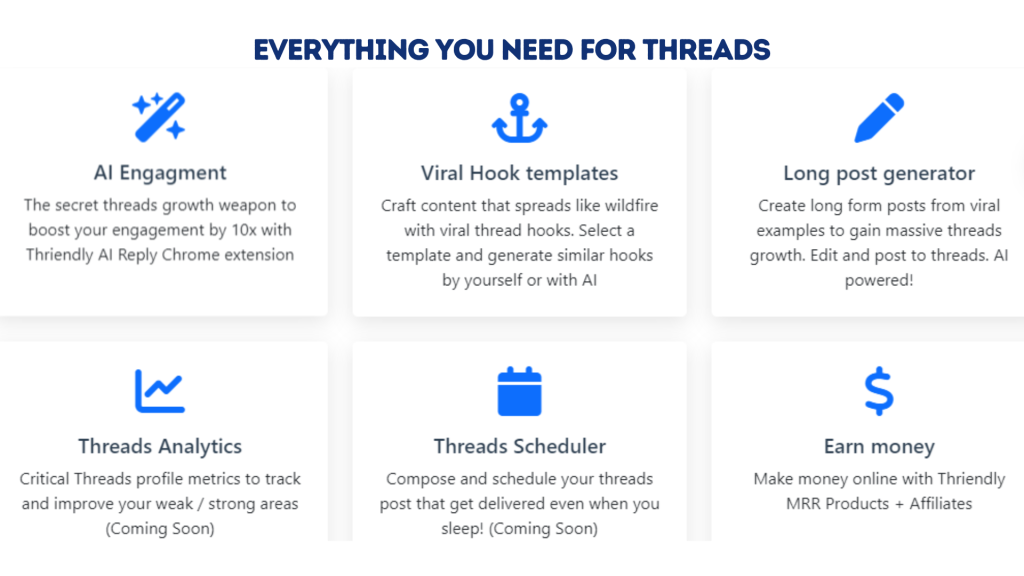
Thriendly is a relatively new social media tool to create, manage, schedule, publish and analyse Threads posts for sustainable growth. You can also use its integrated AI reply feature in your Threads account for engagement.
You can use Thriendly to create Threads posts by typing topics you want you want to post about. It will analyse millions of viral content to come up with the best hooks for engagement and maximise your chance to go viral. You will have access to a Threads scheduler and analytics.
I use this tool to create Threads’ long-form posts and maximise my chance of going viral. I also use the AI reply feature to engage with other creators which boosts my account visibility. The analytics section helps me to analyse metrics and take action for success.
You can create a free account which comes preloaded with 100 credits after which you will have to upgrade to its premium version for $14.99 monthly.
Pros:
- Thriendly boosts your chance of going viral by creating posts for you from templates.
- You can use it for X and boost your engagement with the AI reply feature.
- It offers 100 credits for free accounts which can help you get started.
Cons:
- Some advanced features such as Threads scheduler and analytics require a paid subscription.
- Since it is new, it is still developing new features and adjusting to Threads algorithm.
ADHD Benefits:
- It allows you to create content on the fly with the AI post generator on low-motivation days.
- Thriendly helps to make genuine connections with the AI reply feature on Threads.
Mindfulness and Self-Care Apps To Avoid Digital Overwhelm
18. Balance
Balance is a personalised meditation app designed to improve sleep, reduce stress, and enhance well-being. Social media marketing is an easy field, which is why it is crucial to manage your mental health and work-life balance.

You have access to personalised meditation sessions – guided and free meditation. It offers meditation and exercises to enhance sleep quality and reduce stress. The mindfulness exercises are designed to keep you grounded and relaxed during the day.
I use Balance throughout the day for mindful breaks. I can choose to have a gratitude session, or a nap-styled meditation for an hour and practice loving kindness meditation to reduce stress.
Balance is currently priced at $11.99 monthly or $66.99 yearly for unlimited access to meditation sessions in different settings. You can use this link to get a FREE YEAR of Balance.
Pros:
- Balance is highly adaptable to your preferences and goals.
- It offers both guided and unguided sessions for all levels.
- It has a clean, user-friendly interface.
Cons:
- It has limited free content (though often offers extended free trials)
- Individuals with no experience in meditation may find it difficult at first.
ADHD Benefits:
- The personalizations help maintain interest and engagement.
- The short session options cater to varying attention spans.
- There is excellent progress tracking which provides motivation and reinforcement.
19. Headspace

Headspace is a popular meditation app designed to promote mindfulness, improve sleep quality and reduce stress. It offers a user-friendly interface for guided and unguided meditations.
You can use Headspace to learn how to meditate and learn techniques for lower stress levels. It incorporates various mindfulness practices. You can use it to improve focus through regular mindfulness practice.
I am not currently using it since I use Balance but it is a great alternative as it is recognised worldwide and has a unique interface for its users. It has a good balance between theory and practice.
It is currently priced at $69.99 per year.
Pros:
- It is a well-established app with a large content library – both practice and theory.
- It features engaging animations and easy-to-follow instructions to keep you interested,
- There are options for both beginners and experienced meditators.
Cons:
- Balance requires a paid subscription for full access.
- Some people may find the style too structured or gamified.
ADHD Benefits:
- The variety of content helps maintain interest in such practices.
- There are short, animated videos which explain concepts clearly for beginners.
- The gamification elements can provide extra motivation for users with ADHD.
Bonus: Tips for Implementing New Tools Without Getting Overwhelmed
I have compiled this list of the best social media tools for ADHD entrepreneurs after using many apps and tools over the years. It was not easy to find these tools and apps that truly help. However, your experience and my experience with ADHD may be different, which is why I would encourage you to try them out first before purchasing anything. You can read my Ultimate Guide To Social Media Marketing for ADHD Entrepreneurs here for more actionable steps.
And to avoid getting overwhelmed by the adoption of so many tools and apps, I have put together a few best practices to help you out:
- Start with one tool at a time: do not download a bunch of tools you will not use.
- Set realistic goals for tool adoption: understand that there is a learning curve for some of these tools.
- Use the tools tutorial resources to improve your understanding of how to use the tools
- Join user communities for support and tips
If you would like to have free monthly resources such as life planners and ebooks on organic marketing, you can join my newsletter by clicking on the button below.
What is the best app for people with ADHD?
There is no right answer to this because each individual with ADHD is different. So you have to take your time, test the best tools and recommendations to see which one works best for you!
How do you manage social media with ADHD?
The best way to manage social media when you have ADHD is to use tools and apps that help you overcome the daily challenges of people with ADHD. You can read my Ultimate guide to social media marketing for ADHD entrepreneurs.
What is the best AI tool for people with ADHD?
In my opinion, Monica is the best tool as it combines all AI assistant on one platform and have many more features in-built, which is great to avoid task switching.

